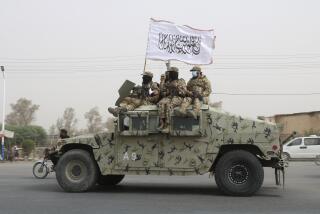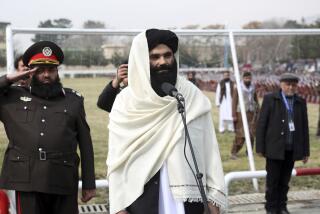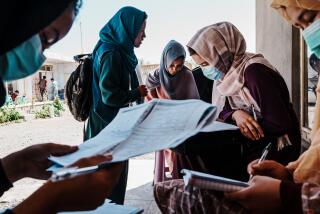Mysterious Afghan Militia on a Mission : War: Taliban believes it is following a vision. Some suspect a Pakistani role.
- Share via
CHARASYAB, Afghanistan — The legend says a poor , pious man who had lost an eye fighting foreign invaders had a startling vision: The Prophet Mohammed appeared and told him to act to stanch the seemingly endless bloodshed in this nation.
Maulavi Mohammed Omar’s revelation electrified boys and men studying in madrasas , or religious schools, in the southeastern city of Kandahar. They were tired of 15 years of warfare and increasing lawlessness. Last August, in their first military engagement, they seized the Spin Buldak armory near the Pakistani border.
Calling themselves the Taliban, or Seekers--from the name traditionally given to Muslim religious students--the disciples of Mohammed Omar numbered as few as 200 at the start. But weapons in hand, success followed success. They came to control several districts of Kandahar, the old royal capital 60 miles from the Pakistani frontier. After sharp battles in October, they took over the entire city.
Then followed what at first blush appears to be a military miracle. The Taliban began pushing northeastward on the road to Kabul, 300 miles distant.
For a week now, they have been bivouacked on the wide, barren plain at Charasyab, 10 miles from the capital, using as their headquarters a two-story, whitewashed hospital they seized without a fight from the mightiest opposition faction, Hezb-i-Islami.
“If you follow the verses of the Holy Koran, then nothing can defeat you--no tanks or atom bombs,” Haji Wali Mohammed, a Taliban fighter, replied when asked to explain his group’s stunning success.
Most surprisingly, for a war-hardened country such as Afghanistan, the Taliban seems to owe its lightning occupation of a third of the rugged, mountainous nation as much to persuasion as to military prowess. Its T-72 tanks and roadside checkpoints fly white banners--the Islamic color of peace.
The young fighters, in turbans and long capes, carry rocket-propelled grenade launchers and Kalashnikov assault rifles. But as a force, they are largely untested in battle, although many participated in the jihad, or Islamic holy war, against the Soviet occupation in the 1980s.
“We have had a few martyrs,” Wali Mohammed acknowledged. He said the group’s goal now was “to bring an Islamic government to Afghanistan.”
Many Afghans and outsiders credit the Taliban’s stunning successes to the badly eroded support of many of Afghanistan’s nine warring moujahedeen factions, which have frittered away the legitimacy and popularity they won by courageously combatting the Soviet invasion.
“They’re energetic, they’re young, they believe in something, and that makes them superior to the ( moujahedeen ) commanders,” said a Western diplomat who recently visited Kandahar to meet with Taliban leaders.
By opening the road that runs north from the Pakistani city of Quetta, they ended highway banditry by rival militias and allowed food and other products to flow freely.
“The way they were clearing the road was to send someone ahead to a checkpoint to say: ‘The Taliban is coming. If you’re innocent, stay. If you’re not, you’ll be hanging from a tree tomorrow,’ ” said one veteran Western humanitarian worker based in Kabul.
The legend behind the rise of the Taliban may be true, or there may be much more than meets the eye. Some suspect that neighboring Pakistan, again trying to act as the puppeteer in Afghanistan, has furnished money, weapons and logistic support.
It is indisputable that students in madrasas , and others among the estimated 1.5 million Afghan exiles in Pakistan, have been coming to join.
What this mysterious group wants for its long-suffering country has come to be urgently relevant. Avowed puritans and strict orthodox Muslims, its members oppose both smoking and television as un-Islamic. Women in the eight provinces in southeastern and southern Afghanistan that the Taliban now controls will not be allowed to work, at least until a new government determines their status, said Abdul Matin, a Taliban member.
He said that because of the “emergency military situation,” some women in Kabul, a city more liberal than the rest of the country, are apprehensive.
“In Islam, there is equality in the rights of people,” objected Rangina, 28, a single woman who works as a cleaner at an international aid agency’s office in Kabul and, along with her brother, feeds a nine-member extended family. “If the Taliban does not let women out to work, then it will be difficult to support the family.”
In opium-producing areas of Afghanistan, where it has taken power, the Taliban has reportedly torched poppy fields and executed drug traffickers.
The Taliban members say their major tactical objective, as a way of restoring peace, is to disarm rival militias who betrayed the ideals of the holy war against the Communists. And yet their true goal is almost uniformly acknowledged to be mastery of the capital, with all the strategic and political advantages that would bring.
“Every effort will be made to take Kabul without fighting,” Mullah Boorjan, the Taliban military commander in Charasyab, told journalists Sunday. “But it will be taken either way.” He said he would wait 20 days, perhaps a month, before invading.
On Monday, soldiers of Ahmed Shah Masoud’s Jamaat-i-Islami militia, the military buttress of Afghanistan’s rump government, were beefing up defenses of the war-devastated capital. About four miles north of the Taliban lines, militia soldiers were digging trenches and had installed truck-mounted rocket launchers to rake the access road.
The Taliban now has only 2,000 men around Kabul, said Haji Mullah Mohammed Rabbani, the group’s chief leader at Charasyab. It was unclear how such a small force could hope to take Kabul from Masoud’s battled-hardened troops. But other Afghan factions have learned to be wary of the Taliban.
The Taliban’s structure is so mysterious it is unclear who really is in charge. The group is said to be run by a high council of eight members and a subordinate council of 22 based in Kandahar. Yet Mohammed Rabbani did not hesitate to refer to Mohammed Omar--who is said to be in his 40s and to have lost his eye in the Islamic uprising that followed the 1979 Soviet invasion--as supreme leader.
The Taliban’s quick successes have exposed the hollowness of some of the nine moujahedeen factions that began warring for power after vanquishing the Communist government in 1992. For still unclear reasons, Gulbuddin Hekmatyar’s Hezb-i-Islami vacated its Charasyab headquarters without a fight, leaving behind half a dozen T-72 tanks and Soviet-made armored personnel carriers.
The Taliban’s rise and objectives are among the main reasons that a U.N.-backed peace plan for Afghanistan that was supposed to take effect Monday is now dead in the water. The Taliban has refused to be a party to the transitional council that is supposed to formally inherit power from Burhanuddin Rabbani, who has served as Afghanistan’s nominal president since 1992.
U.N. sources say Rabbani insists that the Taliban be represented on the council. But the new players in Afghan politics and military affairs object to some of the council’s designated members, including Masoud and the militia headed by northern warlord Abdul Rashid Dostum, who was a general in the former Communist regime.
In Kandahar, where the Taliban have been in charge since October, visitors say they have restored law and order and ended the looting, rape and bullying that had been rife under the militias.
But, in the name of Islamic orthodoxy, the Taliban insists that women wear veils. It banned women from the bazaar, relenting only after merchants complained that women were their main customers. Now, visitors say, women may shop but cannot step in stalls with male vendors.
Taliban members are predominantly Sunni Muslims and members of the Pushtun linguistic group, factors that have created apprehension among Afghanistan’s Shiite minority and other ethnic groups. But the Taliban followers profess tolerance and seem so far to have adhered to this practice.
Among the 700,000 people believed to be living in the center of Kabul, many of whom sleep in unheated buildings turned into wrecked hulks by the factional fighting, there is relief and anxiety at the approach of the Taliban. “The militias understand only fighting. But the Taliban doesn’t like fighting,” Said Sarwar, 27, a Tajik driver, said. “It is necessary that the Taliban (members) come to Kabul. They must remove these people from power. And they must take the weapons away.”
More to Read
Sign up for Essential California
The most important California stories and recommendations in your inbox every morning.
You may occasionally receive promotional content from the Los Angeles Times.













